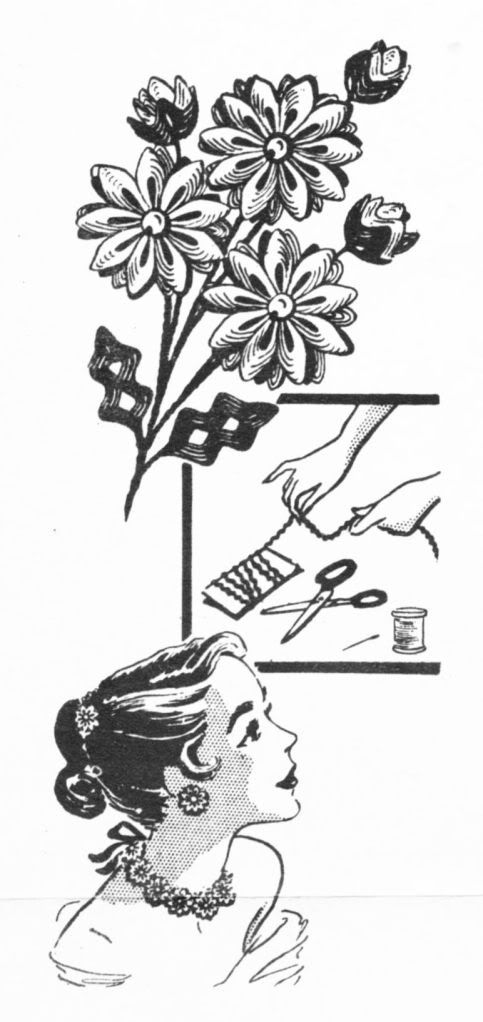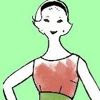Thursday, June 28, 2012
More Messages from the Past
Thursday, June 21, 2012
Make Rick-Rack Jewelry!
Think of the sweet gifts you could make, mixing the colors and sizes to make these very personal and special. Have fun!
This pattern contains complete diagrams and instructions for making rick-rack jewelry. Suggestions are given for other accessory uses.
MATERIAL REQUIREMENTS:
1/2 inch rick-rack in desired color or colors; household cement; thread-, earring backs; pearls or rhinestones for centers; copper screen wire for corsage stems; 1/4 inch ribbon for necklace or bracelet.
CUTTING RICK-RACK: For each flower, cut two pieces of rick-rack so that when ends are pasted together there are 18 points on each side. For each leaf, cut -1 piece of rick-rack so that there are 5 points when finished. For each bud, cut 2 pieces of rick-rack so that there are 4 points when finished.
MAKING FLOWERS: Join strips of rick-rack by overlapping ends and securing them with clear household cement. When cement is dry, cut away excess overlap on both sides. Lay one circle of rickrack inside the other as shown in Detail 1. Run a double thread through points of rick-rack as illustrated in Detail 1 and gather tightly and evenlv (see Detail 2); secure thread. Attach a pearl or rhinestone in center (see Detail 3). Make as many as needed.
MAKING LEAVES: Fold a piece of wire 16 inches long in half. Starting at fold of wire, sew points of rick-rack together and to wire to form leaf as shown in Detail 4. Make as many as needed.
MAKING BUDS: Fold a piece of wire 16 inches long in half. Join ends of each strip for bud same as for flower. Place circles of rick-rack together, run a thread through center (see Detail 5) and pull together tightly; secure thread. Sew bud securely to top of wire. Make as many as needed.
ASSEMBLING FLOWERS ' LEAVES AND BUDS: See Illustrations. CORSAGE: Sew each flower securely to a piece of wire. Arrange leaves,, buds and flowers as desired and wire all together at uppermost point. NECKLACE OR BRACELET: Sew flowers securely to a piece of ribbon. EARRINGS: With household cement, attach back of flowers to earring backs. For suggestions for other uses, see illustrations.
Friday, June 15, 2012
What do these dresses have in common?
Then she had this much more sedate simple sheath with a boxy jacket. More like an office look?
So what did she find? This amazing Simplicity Pattern 2370. It has that sexy low back and the boxy little jacket...plus a terrific overskirt to change out the look. She did well!
(both clippings were found inside the pattern envelope.)
As a side note, the pattern is stamped "Parsons Dept. Store" and the address is across the street from my favorite coffee shop, but nobody remembers a department store ever being there, and I couldn't find out anything online. I'd love to know more.
Wednesday, June 13, 2012
Manikin Model Dolls - 1943
These are hard to find...and not cheap when you do see them. (I know, I've wanted one for years) And actually while they were suppose to teach and encourage young sewers, in fact doll clothes are hard! Ever try to sew tiny, tiny little sleeves into a tiny, tiny little armhole? I suggest leaving doll clothes to the much more experienced sewist, let's not discourage the youngsters!
This was written by Elisabeth May Blondel, a writer and editor for McCall's.
"Learning to fit and make pretty clothes on a modern fashion model means that half the battle's won to young sewers when they come to make their own. Glamor clothes, slacks, dirndls, etc. (1058) look adorable on such fashion models, which are usually about 12 1/2 to 20 inches high."
The Look Of Spring - Box Coat And Reefer - 1943 McCalls Magazine
These illustrations are signed Jean De Vigne who I can find listed as an illustrator on some book covers, but no other details. Any ideas?

THE SEERSUCKER SUIT is a grand institution. This black-and-white one has the short length jacket, and a skirt eased by kick pleats stitched along the edge to keep them crisp. Wear it with blouses or dickeys. No. 5244.
THE SEMI-FITTED REEFER at the right, and turning its back to you above, will soon start collecting admirers. It is just a shade more mannish than most reefers. And this cut makes it wonderful for bulky tweeds. No. 5248.
THE BOXY SHORTIE in yellow wool is a very gay little sports coat which you put on over your suit on shivery days, and wear with shorts, slacks, and extra skirts during the summer. It's double breasted, No. 5247.

COAT OF MANY USES - It is the boxy one shown here twice. Make it as long as the beige, and it is a coat you can use for spring, summer and fall. Make it as brief as the red, and this is a toss-on shortie which you can wear with suits, slacks, shorts and all extra skirts. No. 5242.
CLASSIC COAT FOR TOWN WEAR - It is the reefer, of course. The spring reefer above can be a fall reefer too, if you choose the right color. It is fitted by flattering long, narrow panels, which make one's figure as slim as slim. Good sharp collar, set-in pockets. No. 5211.
Wednesday, June 6, 2012
Three Degrees of Softness - 1943 Dresses

"TAILORED BUT SOFT"--This describes at least half of the new shirtfrocks. Everybody can find a becoming one, now. The yellow dress falls into this softly tailored class, with its curved yokes and the gathers below them. No. 5229
COLLARLESS SHIRTFROCK--Many women like everything about a shirtwaister except its notch collar. The flame-colored dress is for them. The skirt is interesting. It has eight slim gores, the front ones saddle-stitched, No. 5217.
ONE FOR VERY BEST--The green dress is illustrated in a good rayon crape, tested rayon. This is one of the best of the draped style, and simpler to make, really, than a tailored frock. Very nice, too, made of a semi-sheer. No. 5225.
Saturday, June 2, 2012
Plenty of Pleats - To Take Back to Collage -1943
For Collage gals the "peplum is the big attraction". But to wear the navy dress "you have to be young". The yellow dress looks "particularly nice on girls with curls". And of course the pink print is "pretty, summery looking, cool. Of course!
Friday, June 1, 2012
1943 Spring and Summer Wardrobe - McCalls Magazine
One illustration is signed by Blanch Rothschild, who I could only find listed as an American Artist - 1893-1988.

This is a Spring Wardrobe.
The first set include the aqua dress, that is "especially for those who say, 'I can't wear shirtfrocks, they are too severe'. You can wear this one." The dotted crepe, "worn with town accessories, it looks like a soft suit." The Navy with "lingerie touches" has a "swing-over neckline."


To Keep for Summer
There are plenty of details to enjoy here, but I have to admit I think the gray with the contrast bodice does it for me. But maybe I'm influenced by her cute little hat. They do say that it is "a wonderful idea for getting one new dress out of two old ones". Remember this was wartime. The red dress "uses the border edge at the hemline only, which is smart of it.". The blue dress uses eyelet and it is "A good shoulder-broadening style. Use a piece of leftover material, printed or striped, can be used up smartly for yokes and sleeves, as in the white dress".
















